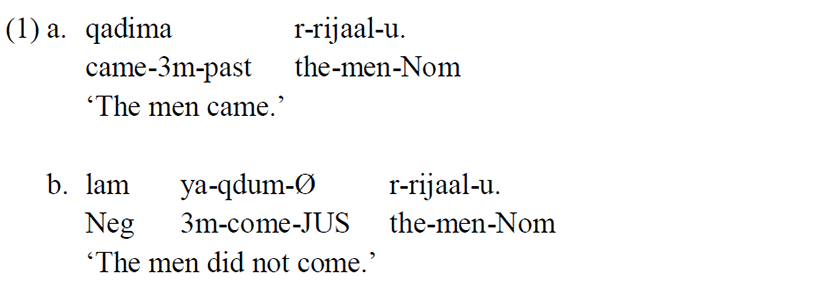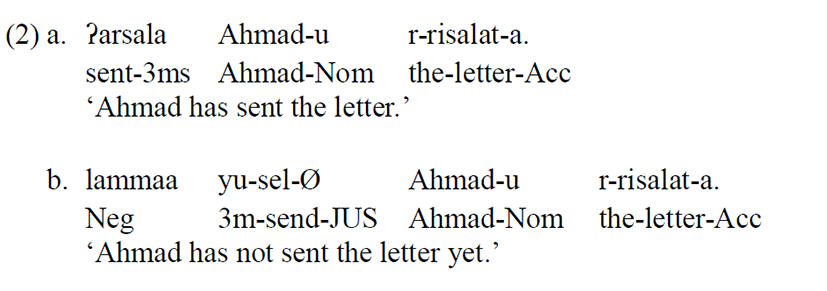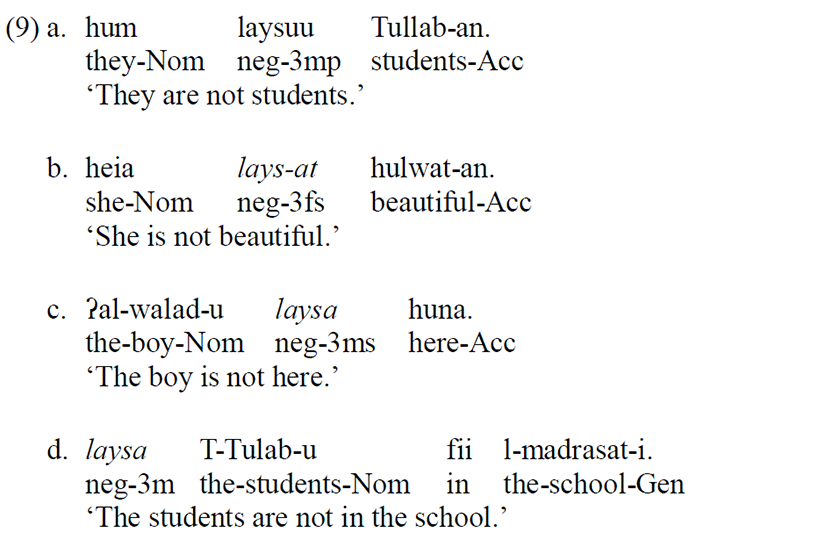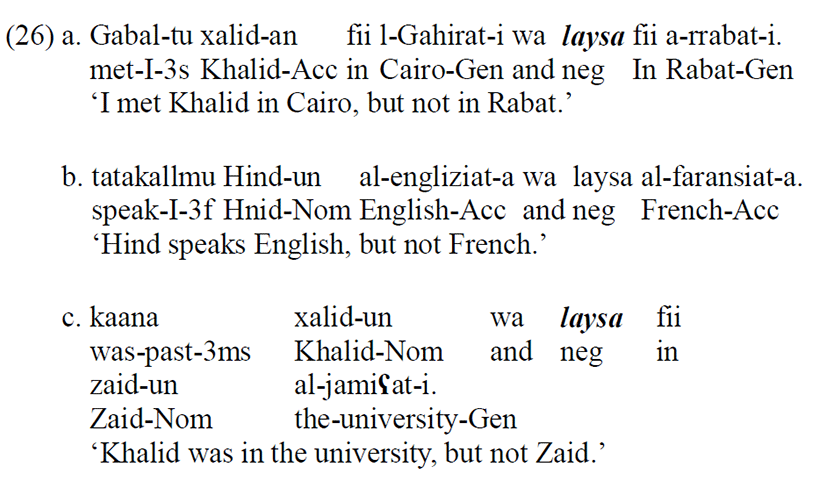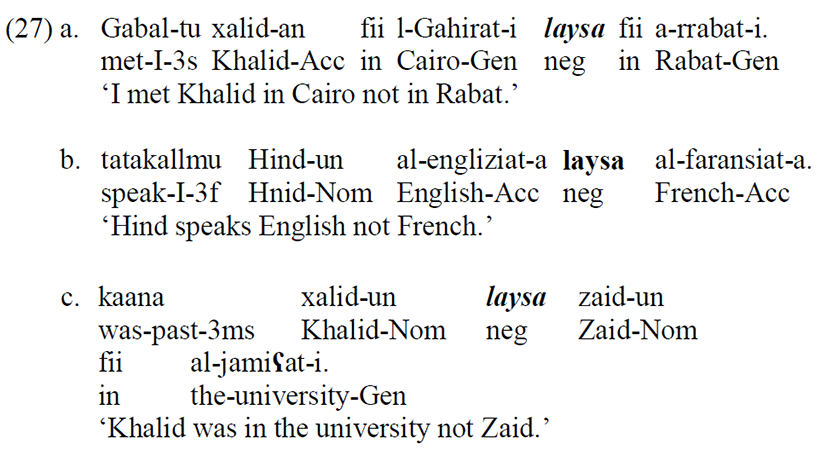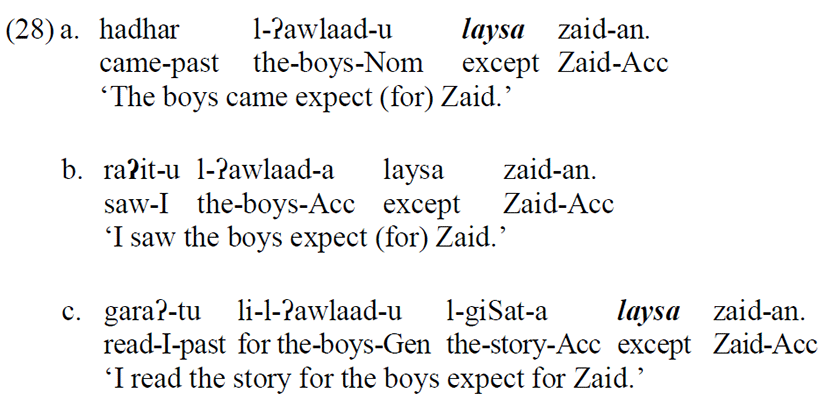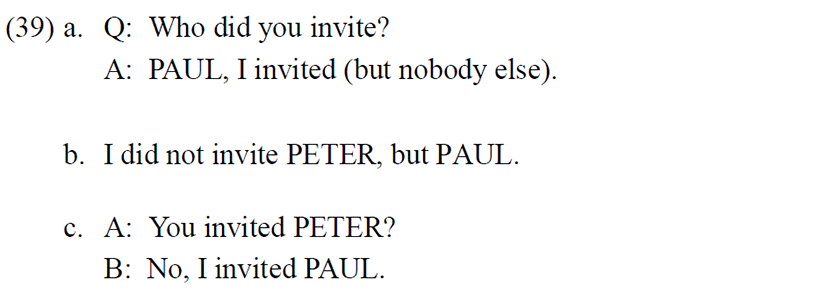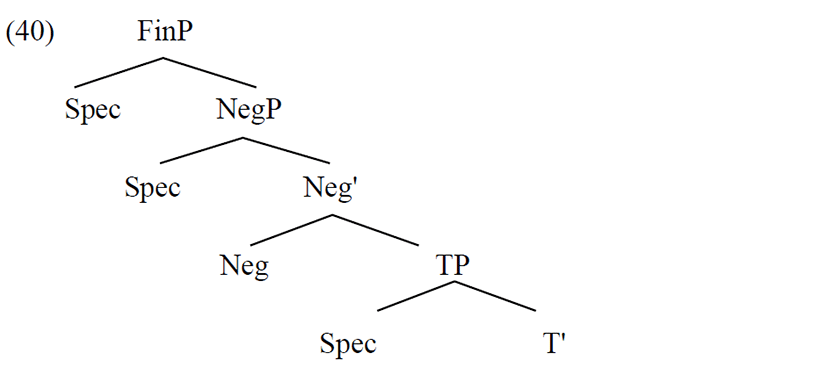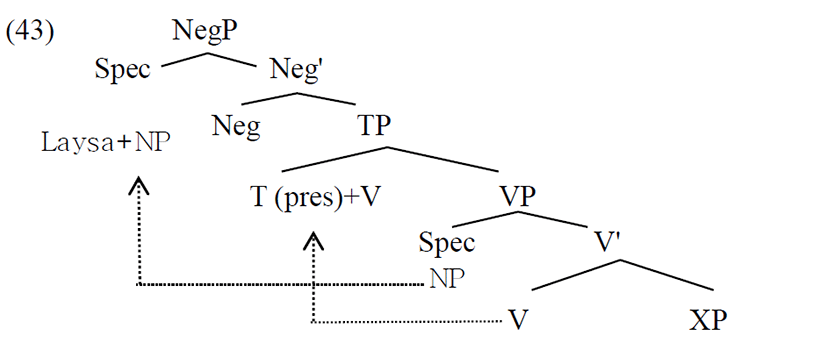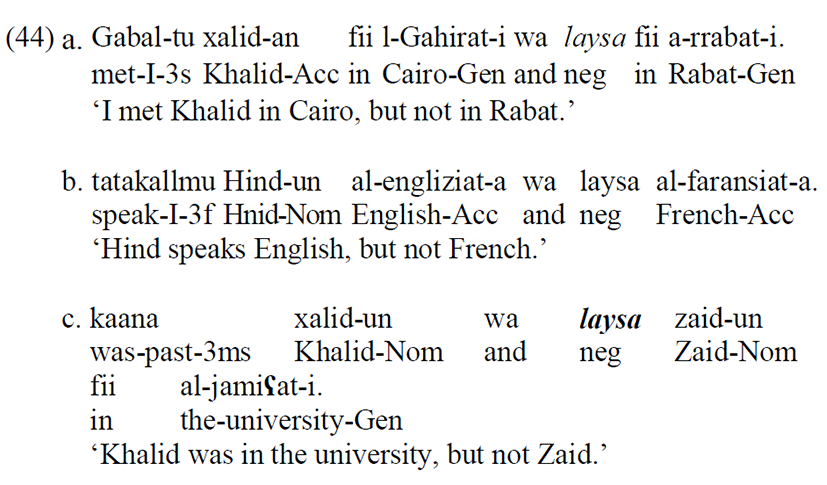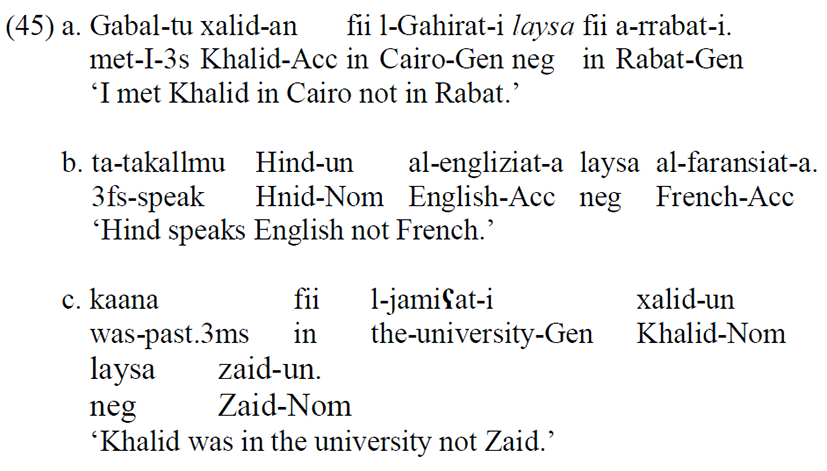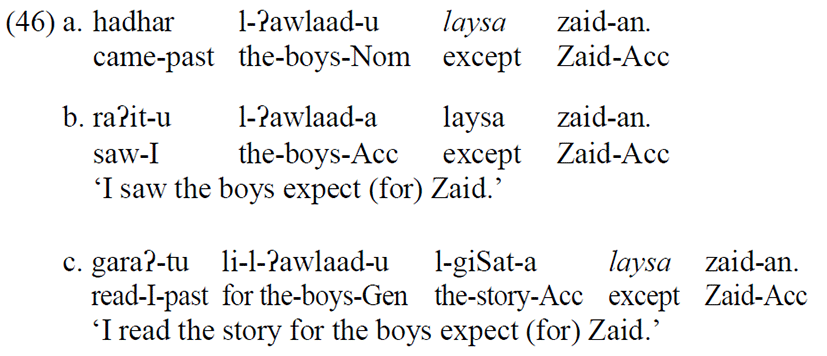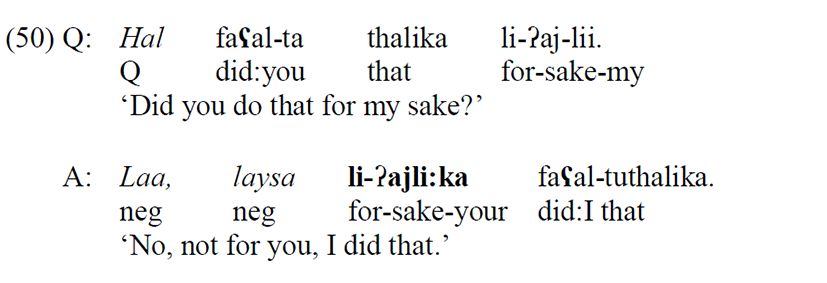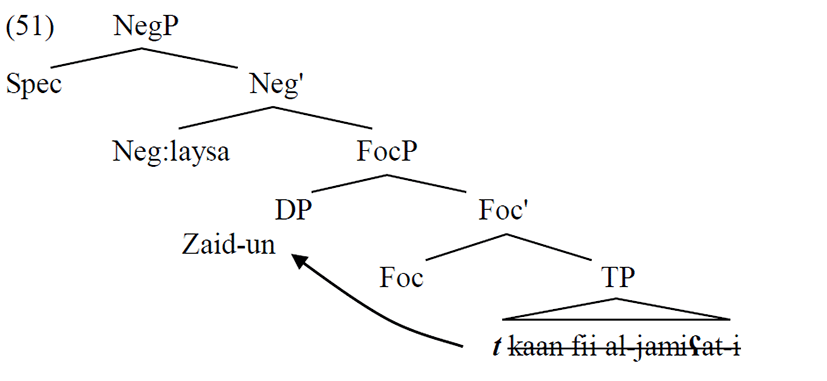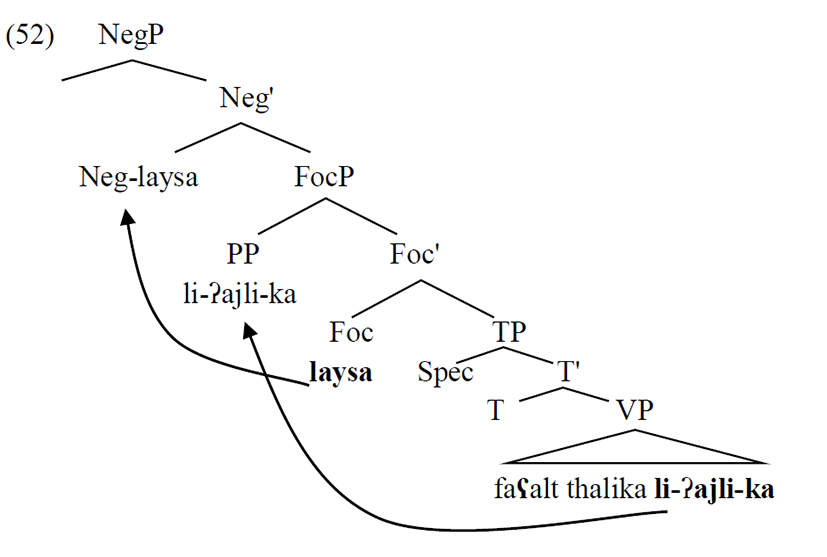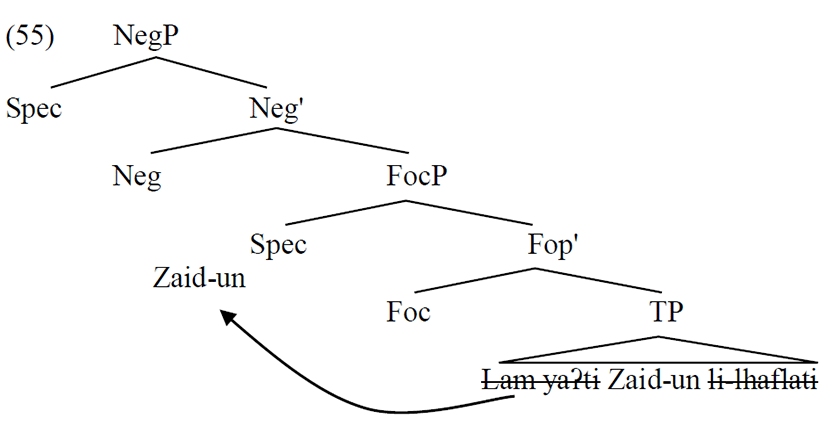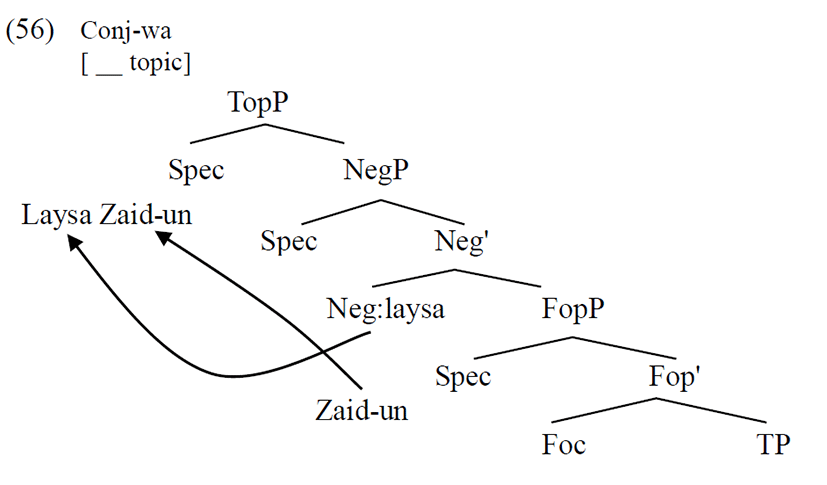1. Introduction
The expression and interpretation of negation in natural language have long fascinated philosophers, logicians, and linguists. One important issue that has attracted much interest in recent linguistics is the interaction of negation with other syntactic and semantic phenomena such as modality, tense, aspect, ellipsis, and information structure (see for example, Ouhalla 1993, de Haan 1997/2013, Zanuttini 1997, Taleghani 2006, Hinterhölzl & van Kemenade 2012, Al-Horais 2013). In this paper, I consider the interaction between negation and information structure by interpreting focus under negation in Standard Arabic (Arabic, for short) via its negative marker (laysa) that has different patterns to express negation. One of these significant patterns, which has not been explored much before, is its distribution of focus features and its role in mapping the syntactic structure to the semantic interpretation.
By borrowing the terminology from the important insights of Herburger (2000) and Etxepare & Uribe-Etxebarria (2008), the current paper argues that laysa uses three different ways to show the interaction between negation and focus. Under the first way, negation takes scope over the whole clause, which is interpreted as focalized (wide focus). Whereas in the second way, negation takes scope only over the element in final position, which constitutes the focus of the sentence (bound focus). Finally, in the third way, the focus in final position is out of the scope of negation (free focus). Each of these foci (wide, bound, free) involves a different derivation and a different syntactic structure located at the syntax-information structure interface. In order account for the derivation of these three types of focus, the paper, by looking at information structure from the vantage point of generative syntax (especially, in its latest theoretical model ‘the Minimalist Program’), argues for a licensing mechanism which is strongly tied to the focus properties interacted in systematic ways with syntax.
The paper is organized as follows. Section 2 begins by laying out data providing an overview of the richness of the Arabic negation system which is expressed in various ways. As a starting point, section 3 briefly touches on the linguistic origin of laysa and then gives a detailed description and explanation of the two syntactic functions exhibited by laysa to express sentential negation (verbal and particle laysa). Section 4 clarifies what exactly the term information structure denotes and how its autonomous notions (topic, focus, and contrast) can be defined and distinguished. The rest of the section discusses and analyzes the interaction between negation and focus in Arabic via accounting for the range of focus interpretations expressed by the negative marker laysa. Section 5 concludes with a summary that concisely recaps the paper’s most important results.
2. The Distribution of Arabic Negative Markers
Arabic has, morphologically, six negative markers. These are laa, lam, lan, lammaa, laysa, and maa (see Fassi Fehri 1993, Benmamoun 2000, Al-Tamari 2001, among others). The distribution of these negative markers falls into three broad classes, which give rise to three main strategies for negating a clause in general:
(i) Negative markers specified only for a [+V feature] (laa, lam, lammaa, lan)1:
(ii) A negative marker specified only for a [+N feature] (laysa):
(iii) A negative marker specified for both [+N/+V feature] (maa):
Leaving the classes in (i) and (iii) aside as they are beyond the scope of current paper, I turn, in the next section, to illustrate some basic facts about laysa before getting down into the discussion of major aim of this paper, namely, the interaction of the negative laysa with the three types of focus.
3. Syntactic Functions of Laysa
Originally, laysa is typically taken to be the result of incorporation of the negative morpheme laa2 and the word ʔysa ‘existence’. For morphological reasons, the second vowel a in laa and the glottal stop in “ʔysa” are omitted, allowing la to be merged with ysa and ending up yielding the form laysa (al-Faraaheedi, 8th Century, 1998 edn, also see Wright 1896). Laysa exhibits two main syntactic functions to express negation: (i) The first function is by means of negative auxiliary verb; (ii) the second one is via functioning as just a negative particle. The intent of the next subsection is to explain the properties of these two functions.
In its main function as a negative verb, laysa occurs with nonverbal predicates (NP, AdjP, advP, PP) and imperfective verbs as shown respectively in (9) and (10) below. Thus, laysa is neither compatible with future tense interpretations (11), nor with verbs inflected for past tense (12) (Fassi Fehri 1993: 208, n. 25).
From the above examples, it can be noted that laysa, as being specified for +N feature, must select NP as pointed out in section 2. Thus, it is ungrammatical for verbal sentences to be negated directly by laysa as illustrated in (13).
This selected NP by laysa can be a full NP as in (9-12) above or a null pronoun that is incorporated with laysa and has a feature bundle (i.e., 3M/F. S/P) indicated by the agreement as in the following examples:
As can be observed in the above examples, laysa cannot act as a full lexical verb since it is not inflected for tense, although it carries number and gender agreement (i.e., enters into agreement with the subject) (al-Khawalda 1997, Ouhalla 2008). This leads early Arab grammarians to treat it “an incomplete verb” (see e.g., Sibawayhi 8th Century, 1938 edn; Abū Ḥayyān 14th Century, 2001 edn). And because laysa assigns nominative case to the subject and accusative case to the predicate as in (17) below, it is reasonable to be considered as an auxiliary verb (al-Khawalda 1997).
The other justification to consider laysa as an auxiliary verb is its mobility in the sense that it can be separated from the verb by the subject. Moreover, it displays the same word order alternations as verbs namely, Neg Subject order and Subject Neg order. Consider the following examples in (18) & (19) below.
Additional evidence to sustain this argument is that laysa can be replaced by kaana or maa kaana which both function in Arabic as an auxiliary verb (El-Rakhawi 1982). Reconsider the example in (19) above, with laysa being replaced by kaana in (20) and maa kaana in (21):
In both sets of examples in (20) and (21), it can be seen that laysa can be replaced by kaana and maa kaana. This is strong evidence that laysa, in all the previous contexts, must be treated as an auxiliary verb.
Laysa, in its second function as a negative particle, does not select a particular tense or carry agreement features. Its lack of inflection singles it out from the negative verb laysa mentioned earlier in the previous section. Laysa functioning as a particle occurs in two different constructions: (i)stripping constructions and (ii) negative-contrast constructions. In both constructions, the particle laysa behaves like a focusing adverb. The following subsections outline the syntactic and semantic properties of laysa as a focusing adverb before dealing with its focusing function in section 4.
Stripping is defined as “a rule that deletes everything in a clause under identity with corresponding parts of a preceding clause, except for one constituent (and sometimes a clause-initial adverb or negative” (Hankamer & Sag 1976: 409, cf. Ross 1969). Stripping always occurs with two-place connectives or determiners which require two paired constituents such as not(22)but not(23), except for(24), too(25) ..., and so on (Kempson 1993: 64).
There are three major ways of expressing stripping constructions by laysa. The first one is that of negating the remnant by laysa contingent to coordinator particle wa. This wa conveys the meaning of English but or and. The second one is via laysa alone without wa. The third way is via negating the remnant with the meaning of except for. In the last way, laysa is traditionally called ‘exceptive particle’ and occurs in Exceptive Sentences that contain two parts: the general thing from which the exception is made, that is, the antecedent, which is the part that generally precedes the particle laysa, and the excepted element. The three ways are spelt out in the following examples respectively.
As can be noted, the remnant preceded by laysa, in the first two types, has syntactic features appropriate to its being a part of a sentence which is structurally identical to the antecedent clause such as having case-marking appropriate to the particular verb or predicate in the antecedent clause. This syntactic requirement, which is met in (26) and (27), proves that the syntactic structure of the remnant is fully projected but not phonologically realized and hence that remnant must be licensed as a part of a full clause3. As for the third type, the excepted element (Zaid) is excluded from the action and therefore has default dependent case (always in accusative case) as indicated by the gloss in (28) above. That is, Zayd is excluded from the action and so cannot agree in case with al-walaad ‘the boys’. To summarize, the remnant must have syntactic features that are either identical to the antecedent clause such as having case-marking as in the first two types or both being homogeneous, namely the antecedent and excepted element as in the third type.
In some contexts, laysa as a focusing adverb negates negative-contrast constructions. It behaves like an indeclinable negative particle, stronger than laa, to deny the sentence part which is merged with (Wright 1896). This special function of laysa is illustrated by the following examples:
From the above examples in (29) and (30), the prepositional phrase (PP) must be merged with laysa as one constituent to create greater negative emphasis. This use of laysa with negative-contrast constructions results in having a contrastive focus negation. Accordingly, the presupposition in (29) and (30) implies contrastiveness and can be read respectively as follows:
Note that laysa here cannot be substituted by either kaana or maa kaana. This means that it is not an auxiliary verb and differs from verbal laysa discussed in section 3.
Moreover, verbal laysa does not imply contrastive focus negation in compared with laysa as a focusing adverb. Consider the contrast in (35) and (36):
In (35) when laysa used as a focusing adverb, the contrastive focus reading is obvious and can be read as:
By contrast, in (36) when laysa is verbal, the contrastive focus reading does not exist. The kind of focus there is merely information focus as will be explained in the following section.
4. Information Structure and Focus Typology
It is appropriate here to provide a clear definition of Information Structure before illustrating the focus typology within the generative syntax framework. Zimmermann & Féry (2010: 1) define Information Structure4 as a “cognitive domain that mediates between the modules of linguistic competence in the narrow sense, such as syntax, phonology, and morphology, and other cognitive faculties which serve the central purpose of the fixation of belief by way of information update, pragmatic reasoning, and general inference processes”.
In generative tradition, it is a widely accepted view that focus provides a highlighted piece of information with respect to the rest of the sentence (e.g., Chomsky 1957). Many recent works on focus typology have shown that two types of foci can be distinguished: information focus and contrastive focus5 (Kiss 1998, López 2000, López & Winkler 2000, Drübig 2003, Winkler 2005, Biezma 2014, among many others). According to Winkler (2005: 28) the essential differentiation of these focus types “is seen in the way these foci are licensed: while information focus, which marks new information in the sentence, is assumed to involve in situ licensing […], contrastive focus is assumed to involve LF-movement of the focus phrase in an appropriate Α-bar position”. To explain this syntactic distinction more precisely, she (p. 29) suggests the derivation represented in (38) below:
Contrastive focus (also known as “identificational focus”: Kiss 1998) does not introduce new information in the same way that information focus does. Contrastive focus may use to correct information or to mark information that contrasts with previously stated (or implicit) information (see Biezma 2014: 95, and references therein). To put it differently, contrastive focus6 is connection with exhaustive answers in question-answer pairs (39a), contrastive statements (39b), or instances of corrective focus (39c) (Zimmermann 2007: 147).
Interpreting focus under negation by laysa is achieved in various types, depending on its function as explained in the preceding section. The two types of focus: information and contrastive focus can be distributed by laysa via three readings of focus. These are wide, bound and free. The following subsections take up these three readings in more detail.
Wide Focus is distributed by laysa used as a verbal negative to take scope over the whole clause. That is, negation with verbal laysa, like the other Arabic negative markers negating verbal sentences (as shown in section 2), is sentential negation which is realized in the clausal spine as NegP7 positioned between FinP and TP (40), and a result of being in this derivational position, it has wide scope: it negates the whole clause. Let us consider the sentence in (10), repeated here as (41):
The negation, by laysa, in (41) above, takes scope over the whole clause, which is focalized. This is shown by the fact that the kind of focus in (41) is information focus as it gives new information that is assumed not to be common knowledge between the speaker and the hearer. The sentence in (41) is the expected answer for the following question in (42):
As wide focus reading in verbal laysa is always associated with information focus, there is no movement involved. It is, as assumed by Winkler (2005), involved in situ licensing. Based on this assumption, I propose that the wide focus reading by verbal laysa is derived as follows. Verbal laysa, by virtue of selecting a particular type of tense (present tense interpretation) and having a NEG feature occupies the head position of the negative projection (NegP) located above TP8, and hence it can attribute the right selectional properties, and their complement is TP, not VP as shown in the simplified derivation in (43) below:
Note that the derivation in (43) further illustrates that the verb moves from V to T achieving the VSO order9, and then the NP moves into Neg to satisfy + N that laysa is specified for as illustrated in section 2. This being the case, the whole clause in (41) is focalized by laysa and no element of the sentence escapes its scope.
The bound focus reading occurs with laysa functioning as a focusing adverb. This reading is realized with contrastive focus distributed by laysa in stripping constructions and negative-contrast constructions as illustrated, respectively, in sections 3.2.1 and 3.2.2. In the bound focus construal, negation takes scope only over one element and lets the rest of the sentence escape its effect. This element is either located in the final position as in stripping constructions in (26-28), reproduced here once again in (44-46), or in the initial position contingent to the negative by being merged with it as in negative-contrast constructions in (29) and (30) repeated here for convenience as (47) and (48).
In the above examples, contrastive focus with laysa gives information which is in conflict with questioner’s expectation, and represents a felicitous answer to disjunctive yes/no questions by delivering a bound negation reading that takes scope only over one element. To illustrate this more, let us, for instance, have the questions of (44c) and (48) to see how the contrastive focus with laysa gives information that is in conflict with questioner’s expectation, and consequently, yields the bound reading over the element in initial or final position which constitutes the focus of the sentence.
Now, let us turn to give a generative analysis to how bonding reading under contrastive focus is derived with laysa in (44c) and (48). In both constructions, I propose that as laysa is a focusing adverb, it has to select a focus projection as its complement. This requires the movement of the focalized element to the specifier of a Focus Phrase located between NegP and TP. However, this movement in (44c) (stripping) is preceded by a process of deletion,10 resulting in structure that is not phonetically realized. For instance, the focalized remnant in the sentence in (44c) above will have the derivation in (51) below:
As for the bounding reading of contrastive focus with laysa negating negative-contrast constructions as in (47) and (48) above, I propose, following Cinque (1999) and Rizzi (2004), who argue that adverbs are licensed in the Spec of dedicated projections, that the bounding reading is derived by movement of the focalized element (PP) to the specifier of a Focus Phrase (FocP). Laysa, as being a focusing adverb, is generated first in the head of FocP then moves to the head of NegP to satisfy its NEG feature and, as a result, it selects a focus projection as its complement. The resulting derived structure is shown in (52) below:
The free construal of focus also occurs with contrastive laysa negating stripping constructions, but with those involve a different derivation and a different syntactic structure in contrast with stripping constructions of bound reading of focus discussed in the previous section. The free reading of focus can be established with laysa negating stripping constructions with two conditions. (i) stripping constructions must have a negation in their two clauses, namely both antecedent and deleted clauses (i.e., laysa must be preceded by a negative clause). (ii) Laysa must be merged with the coordinator particle wa which conveys the meaning English but or and. This can be shown by the following example in (53) below:
Note that the focused phrase (Zaid) in the final position is out of the scope of negation and the right interpretation is (Zaid DID in fact come to the party) [free reading]. If laysa is preceded by a positive clause, only a bound reading is possible, and this reading results as the negation effectively takes scope over the conjunct containing the focus. This can be shown in (44a), repeated here as (54):
Having demonstrated the syntactic structure of the free construal of focus with laysa, let us now turn to propose how this reading is derived. I argue that the cantrastviness in (53) is a sort of contrastive topic and laysa functions as its particle. Fintel (1994), Molnár (1998), and Lee (2003) define contrastive topic as a combined effect of topicality and focusing ‘in the sense that it comes from a potential Topic and somewhat focal in the sense that the choice of the particular part is not known to the hearer’ (Lee 2003: 155). In (54), the hearer thought that Zaid didn’t come to the party, whereas Khalid did. However, the fact was reversed: Zaid DID come to the party, not Khalid. Zaid in the final position is out of the scope of negation, and hence the free reading of focus is only possible.
Based on the above assumption that contrastive topic is a combined effect of topicality and focusing, and following Krifka (1989), Selkirk (1984), and Winkler (2005) who assume that contrastive topics are actually foci, I propose that free reading of focus with laysa is derived as follows. Like the bound focus reading occurred with laysa functioning as a focusing adverb in stripping constructions, the derivation of free focus reading is a combination of movement and deletion. However, the movement operation with free focus construal operates in two steps. First, the focalized remnant (Zaid) escapes deletion by having moved to Spec of FocP lower than NegP deriving the structure shown in (55) below:
Second, the remnant and the negative laysa (by virtue of having the contrastiveness feature) move to the left periphery, to the specifier of a functional projection (TopP) higher than NegP. This movement is triggered by two motivations: (i) the conjunction wa must select (topic), and most importantly, (ii) the Edge-feature in sense of Chomsky’s Minimalist Program (1995, 2008) must be satisfied. Following Winkler (2005: 33), contrastiveness consists of two features: F(oc) and T(op) features and, consequently, it is endowed with the Edge-feature. The only way of satisfying this feature is for a nominal constituent to be moved into the specifier of TopP or FocP11 as what we previously did in both readings of focus: bound and free. If the proposed analysis is along the right lines, this derives the overt structure shown in highly simplified form in (56) below:
5. Conclusion
The paper has considered the role played by the negative laysa in interpreting focus under negation. By fostering an interface-based approach to the interaction between syntax and semantics from a formal generative perspective, the paper has demonstrated that focus can be expressed by laysa in two major types: the information focus and contrastive focus. These major types of focus have led laysa (whether it is verbal or particle) to produce three different readings of focus, namely, wide, bound, and free. These readings, which attributes to the scope of the negation, involve a different derivation in which reflects how the autonomous notions of information structure: topic, focus and contrast interact in systematic ways with syntax. This adds additional support to a large body of empirical and theoretical contributions which cover a wide variety of languages and types of focus to understand what information structural effects play a role at the interface (see, for example, Vallduvi 1992, Rizzi 1997, Vallduvi & Vilkuna 1998, Kennelly 1999, Aboh 2004, Frey 2004, Winkler 2005, Kolokonte 2008, Biezma 2014, Konietzko 2016).
Finally, the paper has proposed a minimalist analysis for each different derivation of these readings and captured the fact that the syntactic position of the negative laysa vis-à-vis negation and its adjacency effect determines the reading of the focus construction as wide, bound, or free. When laysa heads the sentence in its verbal function, the resulting reading is wide, whereas the reading is bound or free in its function as a particle, though they diverge into different derivational directions at the end.

